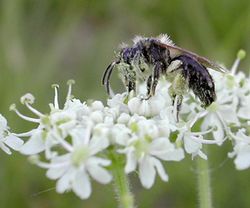Hymenoptera facts for kids
Quick facts for kids Hymenoptera |
|
|---|---|
 |
|
| Andrena sp. | |
| Scientific classification | |
| Kingdom: | |
| Phylum: | |
| Class: | |
| Subclass: | |
| Infraclass: | |
| Superorder: | |
| Order: |
Hymenoptera
|
| Suborders | |
The Hymenoptera is a very large group of insects. It includes many familiar insects like wasps, bees, ants, and sawflies. Scientists have found over 130,000 different kinds of Hymenoptera. Many more are still waiting to be discovered and named.
The name "Hymenoptera" comes from two old Greek words. Hymen means 'membrane', and ptera means 'wings'. This name describes their special wings. Their back wings connect to their front wings with tiny hooks. These hooks are called hamuli.
Female Hymenoptera often have a special tool called an ovipositor. They use it to lay their eggs. This tool helps them place eggs into hosts or other hard-to-reach spots. Sometimes, the ovipositor is changed into a stinger. Young Hymenoptera grow through a process called complete metamorphosis. This means they start as a worm-like larva. Then they become an inactive pupa. Finally, they change into an adult insect.
Contents
What are the Main Groups of Hymenoptera?
Hymenoptera are divided into two main groups, called suborders. These are the Symphyta and the Apocrita. They look a bit different from each other.
Symphyta: The Sawflies
The Symphyta group includes the sawflies. These are the most ancient types of Hymenoptera. Adult sawflies do not have a thin 'waist' between their thorax (middle body part) and their abdomen (back body part).
The female sawfly's ovipositor is special. It is designed for burrowing or sawing into things. They usually use it to cut into plant material.
Apocrita: Bees, Wasps, and Ants
The Apocrita group includes bees, wasps, and ants. Unlike sawflies, these insects have a clear 'waist'. This narrow part is between their thorax and abdomen.
Apocrita are the largest group of Hymenoptera. They include many famous insects that live in colonies. However, the group with the most species is not colonial. These are the many kinds of parasitoid wasps. An example is the Ichneumon wasp.
How Did Hymenoptera Evolve?
Hymenoptera first appeared a very long time ago. This was during the Triassic period. The oldest known fossils of Hymenoptera are from the Sawfly family called Xyelidae. Insects that live in social groups, like ants and some bees, appeared later. They evolved during the Cretaceous period.
Images for kids
-
Bombus muscorum drinking nectar with its long proboscis
-
Symphyta, without a waist: the sawfly Arge pagana
-
Apocrita, with narrow waist: the wasp Vespula germanica
See also
 In Spanish: Himenópteros para niños
In Spanish: Himenópteros para niños




